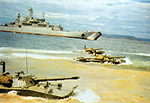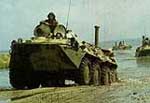| Tell a friend | Print version |
|---|
Soldiers of the Sea
It is an extract from a book “The Fleet of the State of Russia. The roots and origin of the Russian Navy” written by V.Dygalo.
The Marines as a branch of the Armed Forces were introduced for the first time by the English in 1664. In our country the process of their formation is believed to date back to 1668 when a special marines division was formed among the members of the ship “Eagle” crew. Along with the seamen and artillery men, there was a strelets division (riflemen during Peter’s reign) on board of that remarkable ship. In the Naval Regulation of those times (it was called “34 Article Clauses”) the objectives and tasks of this branch of the Armed Forces were specified, particularly as follows: to capture enemies’ ships in the course of boarding. Further developmental impulse was given to the Russian marines during the Northern War with Sweden under the direct leadership of Peter the First.
Cruel bloody war against the Swedish invaders had been going on for two years already. Peter was desperate in forcing our troops to the Gulf of Finland, but the way was blocked by the main bodies which our enemy built up on the Pskovskoe and Chudskoe Lakes. On the 31st of May, five karbasses (boats) with the infantry soldiers on board under the command of Colonel Fedor Tolbuhin launched a surprise attack against the Swedish division consisting of five ships under the flag of Commander Leschern. The battle was launched in a narrow strait between Chudskoe and Pskovskoe Lakes. Under the torrent of bullets and cannons our soldiers on the karbasses, made in rough-and-ready fashion, managed to come close to the enemy’s warships and open accurate firing from the guns throwing self-made grenades at the formidable enemy. For the Swedish large ships the possibility of artillery maneuvers was hindered, while the Russian small light-weight boats, despite suffering serious losses, kept carrying out their bold, daring attacks, storming the Swedish ships. In order to fight the four-cannon yacht “Flundran”, Tolbuhin sent four karbasses that started attacking it from two boards simultaneously. The Russian soldiers immediately started hurling grenades at them, and after that, using rope-ladders, burst into the enemy’s deck. With a help of guns with baginetts (prototype of bayonets which they used to insert into gun muzzles), broadswords and sabers, they seized the yacht, lowered the Swedish ensign and hoisted the Russian one instead. Bewildered and disconcerted, the Swedes soon were knocked out from their advantageous position which enabled the Russians to force their way to Chudskoe Lake.
After the victory gained on Chudskoe Lake, Peter the Great always employed the proved technique of engaging the marines for enemies’ vessels boarding and in landing operations. Late at night on 7 May 1703, a division which consisted of 30 boats carrying soldiers from both Semenovskiy and Preobrazhenskiy Guard regiments under the skilful command of “bombardier captain” (at that time this rank belonged to Peter himself) and lieutenant Alexander Menshikov attacked the ships of Vice-Admiral Numers in the Neva River mouth. The moonlit night did not provide an opportunity for a surprise, but, all of a sudden, storm-clouds gathered and thickened, and the rain started coming down in torrents. Taking full advantage of that favorable situation, our division, under the shelter of darkness, moved along the Neva River bank and, passing round the anchored Swedish ships, suddenly appeared right in front of them. Meanwhile, Menshikov, leading the second group of ships, struck from the Neva River mouth. Taken off guard, the Swedes were hastily trying to set sails, but the contrary wind and lack of possibility for maneuvers did not allow them to join their squadron. Despite the withering, ruinous fire, the Russian ships managed to come close to the galliot “Gedan” and snow “Astrild”. The marines, under the leadership of the Tsar and Alexander Danilovich Menshikov, dashed to attack the Swedish vessels. Only 19 out of 77 Swedish soldiers survived through that battle.
This triumphant victory, gained under Peter’s command, in the very beginning of the Northern War infused courage into Russian soldiers so that they became confident that the Swedes can be beaten not only on land but on sea as well. Following Peter’s order, all the participants of that military operation were decorated with medals: officers with gold medals while the lower ranks – with silver ones. There was a printed saying on the back side of those medals that later became a very popular expression, it went as follows: “Impossible is possible…”
The first battle experience, gained through the military conflicts with enemies’ fleets, revealed the necessity to form regular marine regiments with the Russian Navy. On the 16th of November 1705, Peter the First issued a decree on The First Marine Regiment Formation for the service on the warships as members of the specially-trained boarding-landing troops. It consisted of two battalions of five companies in each. There were 125 soldiers in each company while the overall strength of the battalion was 1250 men, 70 petty officers and 45 officers. This date is generally believed to be the date of the Russian Regular Marines formation.
During the Northern War, the Baltic Sea Fleet became stronger and more experienced. By 1712, there had been already three squadrons. In this connection, under Peter’s decree, five separate marines battalions were formed. “Vice-Admiral’s Battalion”, as a member of the boarding-landing forces, was meant for carrying out military operations on the advance-guard ships; “Admiral’s Battalion” served on the ships situated in the middle sector of the battle-ground; “Rear-Admiral Battalion” was active on the rearguard ships while “Galley Battalion” – for the ships of the Galley Fleet. “Admiralty Battalion” was in charge of guard duty and different missions at the fleet bases. Apart from the standard regular army armament, soldiers of the naval battalions were equipped with cold steel (broadswords, sabers) and fire-arms (guns with baginetts) for boarding operations.
By the beginning of the 1714 military campaign, there were 3 000 mariners in the Russian Navy. 26-27 July 1714, a thoroughly-prepared boarding operation, carried out by the Russian Marines on the galleys, marked the victorious termination of the Gangut battle. During this operation, one frigate, six galleys and three schooners were captured. On the whole, over the years of the Northern War, 65 so-called prize-vessels were captured by the Russian soldiers.
The marines actively served in all the rest military campaigns of the Russian Fleet during the wars that Russia had to wage in the XVIII-XIX Centuries. The siege of Korfu Island in February 1799, one of the most protected and fortified fortresses in Europe, carried out from the seaside with absence of any siege artillery and sufficient number of troops, armaments and food supplies, is an unprecedented and unparalleled case in the entire history of battlers.
During the Patriotic War of 1812, seamen regiments from the Naval Guard crew participated in the Borodino Battle, later, together with the Russian Army, they made all the way to Paris. 75th Black Sea Naval crew was actively engaged in several battles during the 1813-1814 military campaigns as well as in the seizure of Paris.
After the Patriotic War, marine units were disbanded. However, in the Crimean War, during the heroic defense of Sebastopol, 22 naval battalions were re-formed.
Seamen, like all Sebastopol defenders, displayed remarkable, superhuman heroism, courage and valour. During the same war, while defending Petropavlovskiy Port in Kamchatka, the Russian seamen performed wonders of courage and bravery.
The marines did not lose their positions and importance when sailing fleet was replaced with steam one. They took part in repulsing the Japanese fierce assault attacks on the Port-Artur during the Russian-Japanese War.
During the World War I, at the Baltic Sea and Black Sea Fleets, several marine units were formed, particularly for landing on the Bosporus shores. Apart from the marine units, large ships had special detachments consisted of the crew members that were to take part in landing operations.
Engagement of the marines in the landing operations on shore, while defending home bases, coastal areas and main regions, soon was specified as their major task.
During the Civil War of 1918-1922, there were up to 75 000 seamen transferred from ships at the front. They formed separate units, battalions and regiments, however, at that time the marines, as a specific Navy branch, were not officially registered, and after the war they were disbanded. It is only in 1939 that the marines were included in the structure of the Russian Armed Forces. During the years of the Great Patriotic War, soviet mariners greatly contributed to the heroic chronicles. Together with the regular army, more than 500 000 mariners and soldiers of the naval-rifle units were fighting against the formidable enemy in various sectors and zones of the land front. Our mariners displayed remarkable fortitude, determination and heroism while defending Kola Peninsula, Libava, Tallinn, Moonzund Islands, Hanko Peninsula, Moscow and Leningrad. They selflessly fought for Odessa and Sebastopol, Kerch and Novorossiysk destroying the enemy near Stalingrad, defending the Caucasus.
“Everywhere, in the dirty trenches of Odessa, in the pine forests of Leningrad, in the snowdrifts near Moscow, in the impenetrable mountain oak-wood thickets near Sebastopol,- writes Leonid Sobolev in his short story “Seaman’s Soul”,- everywhere, through the casually unbuttoned collars of their protective overcoats, quilted jackets, short sheepskin coats or soldier’s blouses, I saw those dear to my heart blue-white stripes of the seaman’s soul”. The mariners had to fight in the most difficult conditions on the very edge of the landing operations conducted by the Navy together with the Army divisions or on their own. It is the mariners who formed those units and divisions that were sent on the first assault to seize the enemies’ coastal place of arms, and only after their success the main landing troops could start their mission.
Modern Marine Corps is a branch of the Navy aimed at and specially-trained for combat operations conduction as a part of marine landing party (either on their own or together with land forces) and coastal defense (naval bases, ports).
While assaulting the enemies’ naval forces ground and sea bases, deployment posts, ports, islands or detached coastline sectors, mariners can act in the landing operations independently. In those cases when the main landing party consists, mainly, of the ground force units, the marines usually land in the advance-guard in order to seize the most important coastal sectors and zones and to secure the following main bodies landing.
The marines form a part of Armed Forces in many countries. The USA have the most impressive actual marine personnel strength (approximately 200 000 soldiers).
Active service in the marines can be very difficult and exhausting, that is why they are formed out of the most trained young men who possess sound stamina and physical endurance. However, despite all the hardships and lack of comfort that accompany all mariners throughout their service time, the men once served in the marines remain devoted and loyal to their profession forever.
Recruitment for the Russian Armed Forces on a contract basis will, to all appearance, pose even stricter requirements for selection of the future marine service candidates.





